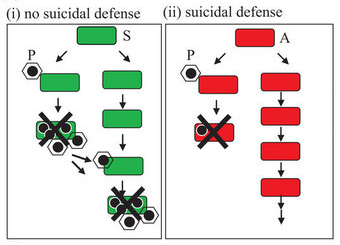Research Abstract
なぜ感染で死ぬのか?自殺型感染防御戦略の成功条件
Success of a suicidal defense strategy against infection in a structured habitat
2012年1月30日 Scientific Reports 2 : 238 doi: 10.1038/srep00238

細菌やウイルスのような微生物は、感染している生き物(ホスト)と共存する方が良さそうな状況でも、強毒性を発揮し、ホストを殺すことがある。これはなぜだろうか。これまでは病原体側に注目した説明がなされてきたが、本研究では、ホスト側の戦略に注目した仮説を検証した。それは、「感染を受けた個体がすぐさま病原体もろとも自殺し、病原体の増殖を妨げると、集団は2次感染から守られる。」というものである。私たちは、数理モデルとリンクしたモデル実験系によって、感染の疫学を解析できるシステムを構築した。そこでは、大腸菌をモデルホスト、それに感染するウイルスをモデル病原体に用いて膨大な個体数を扱う。この実験と大規模シミュレーションを用いて検証を行ったところ、自殺型感染防御戦略は、空間構造があると功を奏し、空間構造がないと効果がないことが示された。また、感染により、病原体に抵抗性のあるホストの変異体だけでなく、ホストに自殺を誘導しない病原体の変異体も現れた。これらの結果は、病原体の高い毒性を考える上で、ホスト側の因子の重要性を示している。この解析系は、感染疫学の様々な問題を解析するのに役立つだろう。
- 東京大学大学院 新領域創成科学研究科
- 日本学術振興会特別研究員
- 総合研究大学院大学 先導科学研究科
- オーストリア国際応用システム解析研究所(オーストリア)
- 東京大学医科学研究所
- 東京大学大学院 理学系研究科
Pathogen infection often leads to the expression of virulence and host death when the host-pathogen symbiosis seems more beneficial for the pathogen. Previously proposed explanations have focused on the pathogen's side. In this work, we tested a hypothesis focused on the host strategy. If a member of a host population dies immediately upon infection aborting pathogen reproduction, it can protect the host population from secondary infections. We tested this "Suicidal Defense Against Infection" (SDAI) hypothesis by developing an experimental infection system that involves a huge number of bacteria as hosts and their virus as pathogen, which is linked to modeling and simulation. Our experiments and simulations demonstrate that a population with SDAI strategy is successful in the presence of spatial structure but fails in its absence. The infection results in emergence of pathogen mutants not inducing the host suicide in addition to host mutants resistant to the pathogen.

